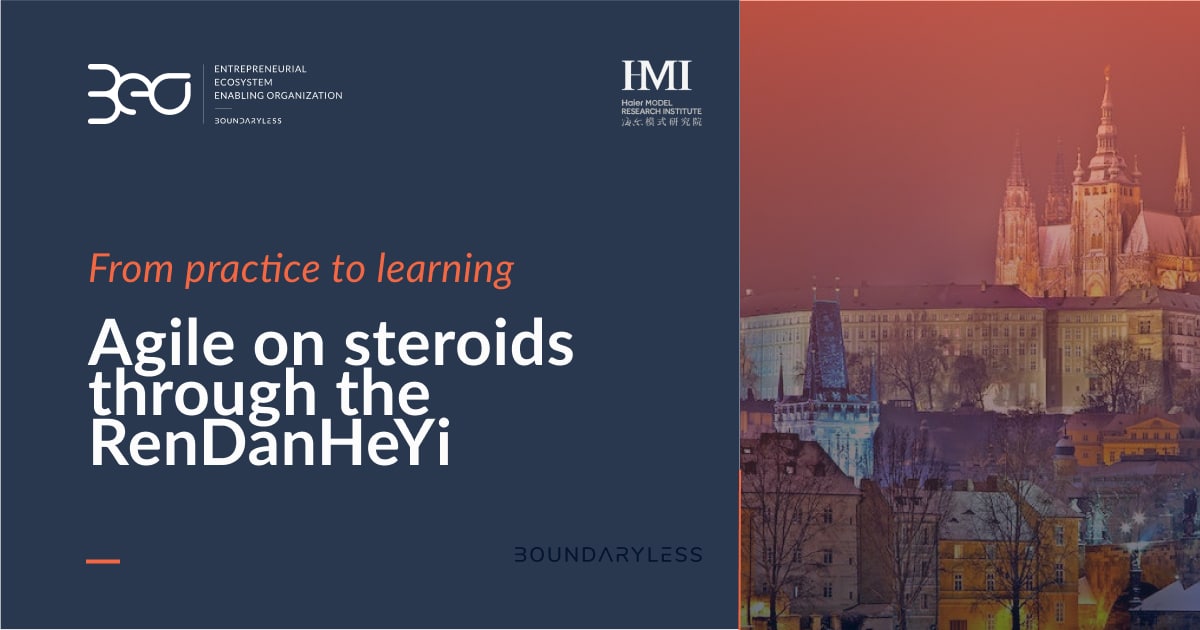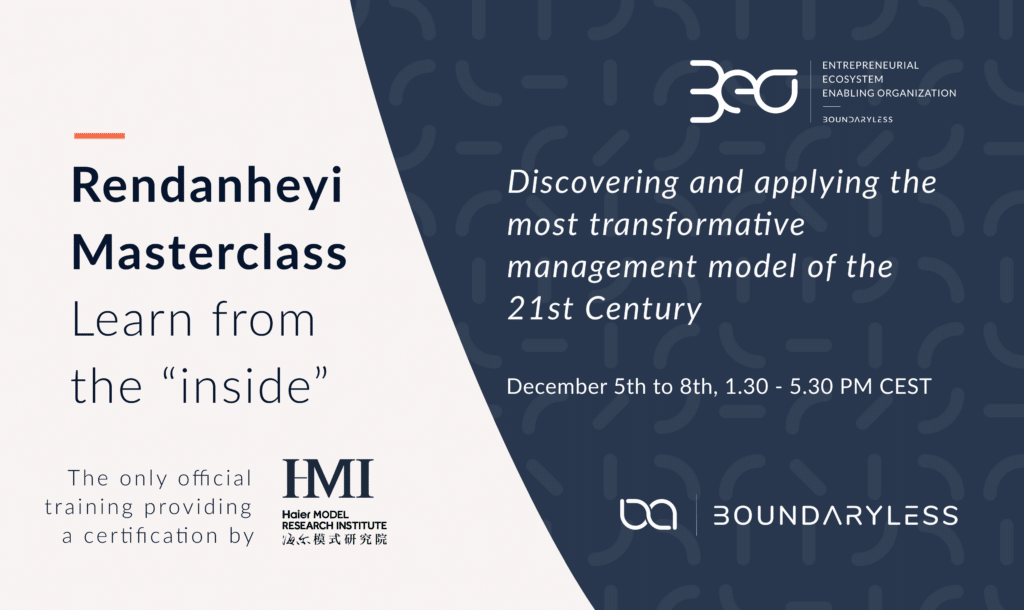Agile on steroids through the RenDanHeYi
Based on evidence that emerged through our participation at the InAgile conference in Prague, this article offers initial insights into the overlap, positioning, shared values, and convergences between RenDanHeYi compared to agile practices.
Emanuele Quintarelli
Abstract
Thanks to an invitation by Edutrea, on the 13th and 14th of June, I had the pleasure to keynote the InAgile conference in Prague, with the goal of introducing a large community of managers, agile coaches, product owners, and other business transformation professionals to the ideas and solutions brought by Haier’s RenDanHeYi.
The event proved as a unique, stimulating, and first-hand opportunity to ponder and reinforce the bridge between the arena of extreme new organizational models, starting from the RenDanHeYi and the entrepreneurial ecosystem enabling organization (the abstraction Boundaryless synthesized to facilitate its adoption beyond China and Haier), with the nowadays pervasive (and yet not always satisfactory) operational experience of agile practices.
This post offers initial insights about the positioning, value, and thinking behind the RenDanHeYi and agile methodologies without referring to any specific scaled agile framework. A future installment will build on it and go deeper into the relationship between RenDanHeYi and SAFe, as experienced by practitioners on the ground.
To know more about the RenDanHeYi, consider joining the 3EO / RenDanHeYi Masterclass planned from the 5th to the 8th of December.

May RenDanHeYi and Agile practices get along well?
Being immersed in a live, energetic, and international agile community such as the one physically coming together at the InAgile Conference in Prague demonstrated agile practitioners’ growing curiosity towards new organizational models that may represent the natural step of evolution for their work. Based on the questions from the audience on the distinctive and often surprising solutions brought by the RenDanHeYi, I had the chance to sketch an initial reflection about the potential convergence between the two worlds.
Virtually any organization has been exposed to, if not already influenced by agile thinking, rituals, and tools. Stand-ups, weeklys, retrospectives, iterative sprints, scrum, kanban boards, or other parts of the agile lingo, and its practices have made their way into most large firms Boundaryless is honored to support. Some recurring questions thus naturally pop up:
- Are agile principles and RenDanHeYi’s values in alignment?
- Should we expect any conflict from adopting RendanHeYi solutions in teams that leverage agile techniques?
- What are the organizational and operational domains mostly impacted by the RenDanHeYi versus those affected by Agile?
- What is, instead, the RenDanHeYi adding to agile approaches?
Let’s go through them, one by one, to draw some conclusions and highlight areas for further consideration.
RenDanHeYi vs Agile at the principles level
While written more than 20 years ago, the principles in the Agile Manifesto still sound like inspiring and useful guides for value creation today. By slightly rephrasing the main ones, we get a list similar to the following:
- The customer is at the helm of attention and value creation
- Fluidity and change around customer needs are seen as a competitive advantage
- Value delivery happens through short and frequent iterations
- Value is measured in terms of customer outcomes
- Teams are multidisciplinary. They unite business and technical expertise at a sustainable pace
- Ventures should put motivated individuals in charge
- The rest of the organization provides support to get the job done
- Teams are self-organized
- Effectiveness in value production is evaluated periodically to learn and improve
- Attention is given to product excellence and good design
Maybe surprisingly, given the different goals, environments, and timing (manufacturing in China in the last 40 years versus software development worldwide 20 years ago), a clear resonance between the RenDanHeYi and the agile world emerges already at the philosophical and values level. A RenDanHeYi-like reply to the Agile Manifesto would feature:
- Zero distance from customers: The same RenDanHeYi word states the direct contact and active role of customers and consumers in co-creating value with the organization.
- Being adaptive: more an agile swarm or a thriving rain forest than a robust coherent monolith, 3EO organizations systematize the opportunity for hundreds or thousands of new ventures (Micro-Enterprises) to sense and act on market opportunities swiftly. The organization is a living, constantly changing organism guided by internal and external stimuli and brave investments, more than senior management’s gut feeling.
- Iterative value creation: Both VAMs (the incubation contract through which a Micro-Enterprise establishes its goals and receives funding from Haier’s Industry Platforms) and EMC Contracts (the foundation agreement for collaborations of Micro-Enterprises) are inherently iterative, with bets that should be won within pre-determined deadlines but also ample space for feedback collection, internal reviews, pivoting and refinement, both in the goals and in the delivery.
- Small smart enterprises over teams: well beyond simple teams assigned to a self-contained capability with motivated employees, Micro-Enterprises are real companies with a distinct profit and loss responsibility, hiring and strategy freedom, and the possibility of profit sharing. Employees become (formally or informally) energized entrepreneurs pursuing stretchy initiatives they feel ownership about, still within a somewhat protected environment (the broader organization). What could be more motivating than this? The team is also self-managed, taking complete accountability for its activity under the coordination, more than the control, of one of its members.
- The importance of supporting functions: if a lean focus on the minimum set of activities the team should look after to ship the product is adamant in the agile world, the RenDanHeYi codifies the other side of this coin through Shared Service Platforms providing the enabling capabilities customer-facing teams necessitate to achieve their goals as smoothly and lightly as possible. In a subtle but extremely powerful balance between centralization and decentralization, everyone is busy getting the job done.
- Leading goals as the beacon: the leading targets included in a VAM establish a Micro-Enterprise / Industry Platform alignment in terms of expected results but pose no limits on the means to achieve them. Based on this medium/long-term expectation, both MEs and EMCs have the chance to periodically (at each inflection point) review and revise their effectiveness, share feedback, and act on it for the team and customer benefit. The end goal is always product and experience excellence with the minimum overhead and supervision possible.
From values to practice. Where is each one playing?
One level down from principles to tangible design decisions, the RenDanHeYi and original team-centric agile practices appear indeed not only consistent but also complimentary.
Agile’s rituals are primary aids to energize and facilitate more autonomy, leanness, motivation, coordination, and responsiveness within the team. Shared planning, reviews, stand-ups, and visual boards all invite an easier, more effective, and less bureaucratic collaboration among members belonging to the same team. What happens beyond this group (for example, the creation of a squad, portfolio management, budgeting, etc.) tends to remain excluded from the picture described by initial agile practices. Higher-level, more organizational dependencies, cross-team interlocks, and boundaries are where attempts such as Scrum of Scrum, Less, and SAFe enter the picture. While we will cover some of these aspects in the future, scaled agile approaches historically desire to help organizations reap the benefits of a leaner work model beyond the team and IT professionals, hoping to achieve business agility more than team effectiveness or speed.
From such regard, the RenDanHeYi follows the opposite path. It is a mindset and solution born for massive scale and autonomy, transforming teams into companies and employees into entrepreneurs. Focused more on how to get rid of managerial layers, supervision, middlemen, and slow, bureaucratic control mechanisms, the RenDanHeYi cares primarily about interfaces among Micro-Enterprises than the rules and suggested behaviors within a single team. Especially Ecosystem Micro-Communities provide a never seen before silo-busting, cross-functional, user-centric way to quickly attract, align and coordinate a partnership of internal and external actors toward challenging customer experiences. The traits of the collaboration are specified in terms of contribution, performance expectations, and value sharing. On the contrary, not much is said about how this will happen, according to an idea of complete freedom of the execution within Micro-Enterprises.
Benefiting from shared principles but acting at non-overlapping organizational levels implies a real possibility to leverage the best of two worlds:
- Agile practices and tools at the team level
- RenDanHeYi artifacts and tools (such as the upcoming EMCOs software) at the organizational level
Boundaryless itself is successfully performing an experiment that mixes the RenDanHeYi (with Micro-Enterprises, EMCs, and Industry Platforms) and Sociocracy. While Sociocracy offers support mostly at aligning multiple domains of responsibility and achieving participative decision-making across Micro-Enterprises, our experience demonstrates how easily the RenDanHeYi can accommodate and be enriched by other self-management and self-organization techniques.
The only area of attention in the relationship between the RenDanHeYi and Agile concerns the twofold nature of the team: in addition to taking over the responsibility of autonomously and iteratively getting work done in line with agile expectations, according to the RenDanHeYi, each team is also a Micro-Enterprise with its own banking account, P&L responsibility, ownership of its lifecycle, team selection, coordination, and management plus the necessity of sharing results among them. Typical agile project management software and practices are not meant to address it.
The unique value of Haier’s RenDanHeYi
When first discovering the RenDanHeYi, agile practitioners immediately get curious about what Haier’s peculiar model could help their organizations uniquely achieve by building on top of the way of working already adopted. In our experience, the following is the real delta and actual driver for agile firms to explore a next step through the RenDanHeYi:
- Finally, encoding agile principles into the organizational structure. Instead of letting teams fight to adopt and maintain agile practices in external contexts that remain slow, hierarchical, bureaucratic, and inherently non-agile, the RenDanHeYi scientifically gets rid of all non-value-creating structures and profiles, transforming an agile team into an autonomous and entrepreneurial company.
- Moving beyond technology or IT teams. Through its origination in a manufacturing environment, it is credible to apply the RenDanHeYi everywhere, not only in IT-centric firms or software development teams. We could say its focus is business-wide agility, innovation, and customer-centricity.
- Formalizing the support agile teams deserve. Shared Service Platforms, as a matter of fact, implement the help customer-facing teams require to be successful. Agility goes beyond individual functions to become pervasive in the entire organization.
- Rethinking incentivization. Tackling pay, rewarding, and profit sharing in new ways remains a taboo in most agile organizations. Not in the RenDanHeYi, where every mechanism, salary included, is revised to foster alignment and collaboration towards customer goals. Unfortunately, asking for proactiveness, creativity, and closeness to customers without recognizing it in terms of hard enablers guarantees limited impact.
- Promoting adaptability to a strategic priority. Thanks to its connection to ecosystems, marketplaces, and product portfolio, the RenDanHeYi empowers product teams to close the gap with business and organizational design specialists and to work side by side with senior business stakeholders. More than a treasure for its technical competencies, the team becomes part of an entrepreneurial organization and is perceived as a crucial enabler of business success.
Conclusions
Thanks to the InAgile conference, we had the opportunity to initiate a long-term dialogue and reflection about the commonalities, opportunities for contamination, and potential differences between agile practices and the RenDanHeYi.
We discovered an ocean of complementarity with unique specialties to be re-used and integrated. In the following post, we’ll see if and how these hints will remain true when considering scaled agile frameworks such as SAFe.
Are you into future-proof organization design concepts, techniques, and tools?
Join us at the upcoming 3EO / RenDanHeYi Live Masterclass in December:

Before You Go!
As you may know, everything we do is released in Creative Commons for you to use. If you’re getting value out of these reads and tools, we encourage you to share with your friends as this will help us get more exposure and, hopefully, work more on developing these tools.
If you liked this post, please consider following us also on Twitter.
Thanks for your support!
